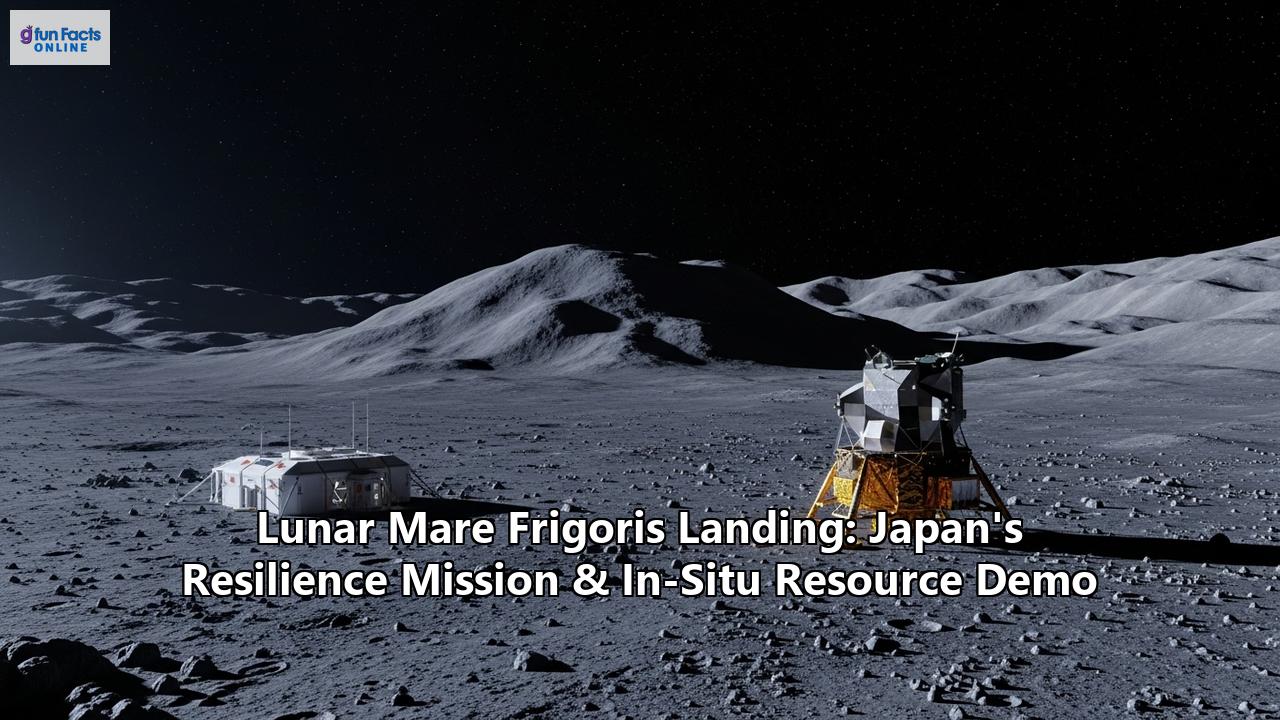Japan is on the cusp of a monumental achievement in space exploration as the private company ispace's "Resilience" lunar lander targets a historic touchdown in Mare Frigoris, the "Sea of Cold," today, June 5, 2025 (EDT) / June 6, 2025 (JST). This ambitious venture, known as Hakuto-R Mission 2, is not just a testament to Japan's burgeoning prowess in the commercial space race but also a crucial demonstration of resilience and a pioneering step towards utilizing lunar resources.
Launched on January 15, 2025, aboard a SpaceX Falcon 9 rocket, the Resilience lander has undertaken a carefully planned, low-energy trajectory to the Moon, arriving in lunar orbit in early May. The mission carries the hopes of a nation and a company that has learned invaluable lessons from past challenges. This is ispace's second lunar landing attempt; their first, Hakuto-R Mission 1, unfortunately ended in a crash in April 2023. The very name "Resilience" embodies the spirit of this renewed effort, reflecting significant upgrades to navigation systems and landing software based on the exhaustive analysis of the previous mission's data. Engineers believe a software issue that incorrectly assessed the lander's altitude during its final descent was the cause of the 2023 failure, a critical lesson that has informed the design and operational strategy of this current mission.
The chosen landing site, Mare Frigoris, is a vast, relatively smooth basaltic plain in the Moon's northern hemisphere. Stretching over 1,400 kilometers, this long and thin "sea" is an intriguing geological feature, distinct from the more circular maria commonly observed on the Moon. Its relatively stable terrain and favorable conditions make it a suitable target for robotic missions, offering a safe environment for Resilience's touchdown and subsequent operations. This region, formed by ancient lava flows, presents a unique area for scientific investigation.
Awaiting deployment upon a successful landing is the "Tenacious" micro rover, a key component of the mission's In-Situ Resource Utilization (ISRU) demonstration. Weighing approximately 11 pounds (5 kilograms), this carbon-fiber-reinforced, four-wheeled rover is equipped with a high-definition camera and, crucially, a small shovel. Tenacious's primary task is to collect a sample of lunar regolith – the fine-grained dust and broken rock covering the Moon's surface. This collected material is part of an agreement with NASA, which, if fulfilled, would mark the world's first commercial transaction of lunar resources. Such a demonstration is a vital step in proving the feasibility of using local materials for future, long-term lunar habitats and exploration, reducing the immense cost and complexity of hauling everything from Earth. The data gathered by Tenacious will directly support NASA's Artemis program and Japan's collaborative efforts in sustainable lunar exploration. The rover and lander are expected to operate for about two Earth weeks, the duration of a lunar day, before the harsh lunar night sets in.
Beyond the ISRU demonstration, the Resilience lander carries other significant payloads. These include a water electrolyzer experiment to test technology for producing hydrogen and oxygen from water ice (if found), an algae-based food production module to explore sustainable life support systems, and a deep space radiation monitor provided by Taiwan, which will gather data crucial for ensuring the safety of future crewed missions. The European Space Agency's (ESA) ESTRACK ground network is providing crucial communications support between the lander and ispace's Mission Control Center in Tokyo.
This mission is a significant marker in Japan's broader lunar ambitions. The Japan Aerospace Exploration Agency (JAXA) has already celebrated the remarkable success of its Smart Lander for Investigating Moon (SLIM) mission, which achieved an unprecedentedly precise "pinpoint" landing in January 2024, making Japan the fifth nation to soft-land a spacecraft on the Moon. SLIM's success showcased advanced landing technologies that will be vital for future missions targeting specific, scientifically rich, or resource-abundant locations.
Japan is also a key international partner in NASA's Artemis program, which aims to return humans to the Moon and establish a sustainable lunar presence. This collaboration includes the development of a pressurized lunar rover by Japan, designed to allow astronauts to travel farther and work for longer periods on the lunar surface. In return, Japanese astronauts are expected to have opportunities to travel to the lunar surface on future Artemis missions, with a shared goal for a Japanese national to be the first non-American astronaut to land on the Moon.
Future Japanese lunar endeavors include the Lunar Polar Exploration Mission (LUPEX), a joint project with the Indian Space Research Organisation (ISRO), slated for launch around 2025-2026. LUPEX will target the lunar south pole to investigate the potential presence and abundance of water ice, a critical resource for future ISRU applications like producing rocket fuel and breathable air. JAXA's long-term space exploration roadmap envisions a sustained human presence on the Moon, with ISRU playing a central role in making this vision a reality.
The success of ispace's Resilience mission would be a landmark achievement, not only making it the first private Japanese company to land on the Moon but also solidifying Japan's position as a formidable player in the rapidly expanding commercial lunar landscape. It underscores a global shift towards leveraging private enterprise to achieve ambitious space exploration goals. With the landing attempt imminent, the world watches, anticipating a new chapter in lunar exploration, driven by resilience, innovation, and the quest to unlock the Moon's resources for the future of humanity. The live webcast, available on ispace's YouTube channel, began about an hour before the scheduled landing time, inviting the public to witness this historic event.
Reference:
- https://www.space.com/astronomy/moon/japanese-company-ispace-will-attempt-historic-moon-landing-on-june-5
- https://ispace-inc.com/news-en/?p=7631
- https://www.space.com/astronomy/moon/private-japanese-spacecraft-will-attempt-to-land-in-the-moons-sea-of-cold-this-week
- https://www.thestar.com.my/aseanplus/aseanplus-news/2025/06/05/japan039s-ispace-counts-down-to-second-moon-landing-attempt-on-june-6
- https://halifax.citynews.ca/2025/06/05/private-japanese-lunar-lander-heads-toward-a-touchdown-in-the-moons-far-north/
- https://www.esa.int/Enabling_Support/Operations/ESA_Ground_Stations/ESA_supports_Moon_mission_carrying_first_European_rover
- https://www.youtube.com/watch?v=Zb8MPDISs68
- https://nssdc.gsfc.nasa.gov/nmc/spacecraft/display.action?id=RESILIENC
- https://www.binance.com/en/square/post/25177132948138
- https://www.japantimes.co.jp/news/2024/01/22/japan/science-health/jaxa-lunar-mission-analysis/
- https://news.yahoo.com/japanese-company-ispace-attempt-historic-160000206.html
- https://ispace-inc.com/news-en/?p=6120
- https://www.skyatnightmagazine.com/astrophotography/moon/mare-frigoris
- http://andrewplanck.com/mare-frigoris-only-lunar-mare-patch-not-circular/
- https://www.researchgate.net/publication/324218520_Mineralogy_of_Mare_Frigoris
- https://www.forbes.com/sites/jamiecartereurope/2025/06/03/japan-is-about-to-land-on-the-moon---heres-how-to-watch-it-live/
- https://mynews13.com/fl/orlando/space/2025/06/04/japans-ispace-attempts-to-land-on-the-moon
- https://www.lpi.usra.edu/publications/newsletters/lpib/new/nasa-selects-companies-to-collect-lunar-resources-for-artemis-demonstrations/
- https://www.nasa.gov/news-release/nasa-selects-companies-to-collect-lunar-resources-for-artemis-demonstrations/
- https://www.icrt.com.tw/info_details.php?mlevel1=6&mlevel2=12&news_id=283816
- https://www.jstage.jst.go.jp/article/tastj/14/ists30/14_Pk_35/_article
- https://www.nasa.gov/overview-in-situ-resource-utilization/
- https://www.planetary.org/space-missions/slim-japans-precision-lunar-lander
- https://www.exploration.jaxa.jp/e/activities/index.html
- https://marsonearthproject.org/on-the-anniversary-of-its-launch-what-happened-to-slim/
- https://www.unoosa.org/documents/pdf/copuos/lsc/2024/TechnicalPresentations/April_19_morning/1_--_19_April_AM_JAXA_SLIM_results_ueda_20240411.pdf
- https://iafastro.directory/iac/archive/browse/GLEX-2025/1/2/92902/
- https://www.nasa.gov/news-release/nasa-japan-advance-space-cooperation-sign-agreement-for-lunar-rover/
- https://asiamattersforamerica.org/articles/us-japan-space-cooperation-in-the-artemis-generation
- https://bsgn.esa.int/wp-content/uploads/2024/12/Masaya-Murata_Lunar-Comm-Nav-Session.pdf
- https://humans-in-space.jaxa.jp/en/news/detail/003924.html
- https://payloadspace.com/japans-bet-on-the-worlds-lunar-race/
- https://en.wikipedia.org/wiki/Japanese_Lunar_Exploration_Program
- https://span.ac.uk/wp-content/uploads/2024/09/Global-Exploration-Roadmap.pdf
- https://humans-in-space.jaxa.jp/en/news/detail/001529.html

